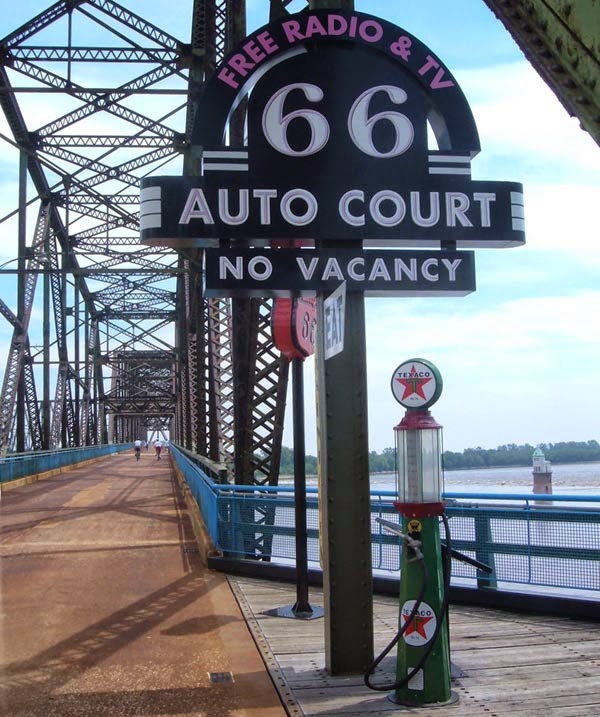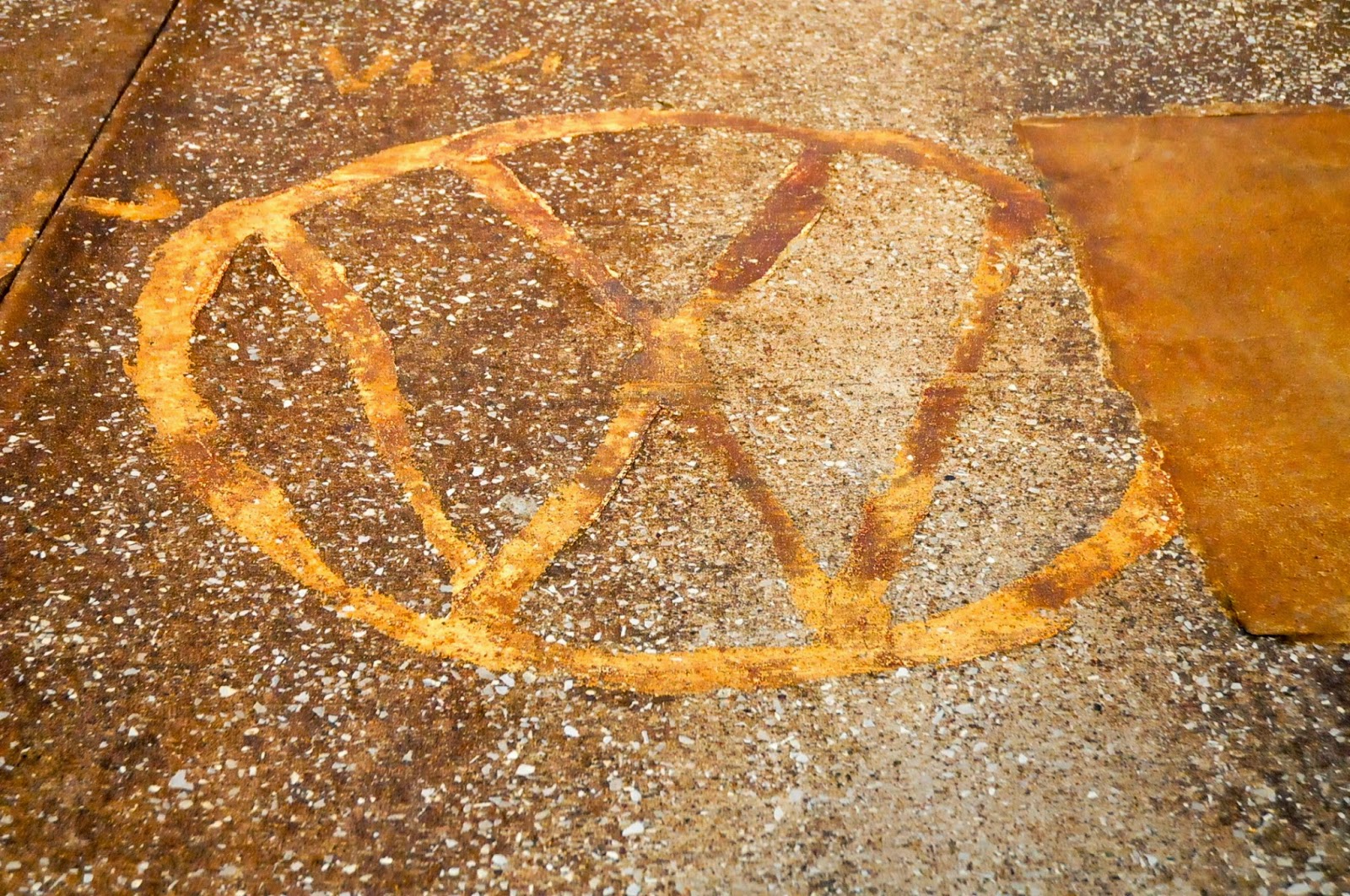The bridge was built by a private venture for ~$2.5M and opened to vehicular traffic in 1929 (source). The bridge company relied on tolls to operate the bridge which once carried the legendary Route 66, bypassing the Mother Road from its former route directly through the southern part of downtown St. Louis south on the MacArthur Bridge. A federal mandate stripped the company of the ability to charge tolls and the butt-ugly, boring, staid, New Chain of Rocks bridge (opened to traffic in 1966) immediately to the north. This was the death-knell for the old Chain of Rocks bridge, closing in 1968.
Thankfully, kismet was on the side of the bridge and my favorite city's history. The bridge was nearly destroyed by the Feds but was spared due to luck and circumstance:
"The bridge deteriorated, and during the 1970s, Army demolition teams considered blowing it up just for practice. In 1975, demolition seemed eminent. Fortunately for the bridge, a bad market saved the day. The value of scrap steel plummeted, making demolition no longer profitable. At that point, the Chain of Rocks Bridge entered 20 years of bridge limbo--too expensive to tear down, too narrow and outdated to carry modern vehicles." (source)This is one of three bridges you can walk across in St. Louis, the majestic Eads bridge downtown and the McKinley Bridge are the other ones. Sure, they have better views of Downtown St. Louis, but the Chain of Rocks is my favorite for walking because it is pedestrian only, whereas Eads carries vehicles and Metrolink and McKinley carries cars. It gives the bridge a peaceful experience like no other and it is unique for other reasons.
First, a walk across this bridge affords the best views of the Mississippi River itself with muddy water rushing over a shoal of limestone rocks for which the bridge takes its name just to the south. This forms raging rapids that can easily be seen and heard from the bridge's deck. It is a lesson in the power of the river and a reminder of why recreational boats and yachts are limited on this stretch of the Mississippi and why locks were engineered for barge passage.
Secondly, there are distant views of downtown St. Louis and the Gateway Arch reminding you that no matter whether you are in the northernmost, southernmost or westernmost edge of the city, you can still find a view of the of cities greatest mid-century modern sculpture. And then of course, you have unbeatable views of the two majestic mini-castle water intakes. These are still a functioning part of the St. Louis waterworks. The site was selected in 1865, the year the Civil War ended. The water plant commenced operations in 1895 and when a filtration system was added in 1915 it was the largest water filtration water plant in the world. St. Louis was built to be great.
Intake Tower #1 (1894)
Intake Tower #2 (1915)
Thirdly, this bridge was featured (among many other St. Louis spots) in the 1981 movie Escape from New York starring Kurt Russell and featuring one of my favorites, Harry Dean Stanton. It is storied that director John Carpenter purchased the Old Chain of Rocks Bridge in St Louis for $1 from the government and then returned it to them for the same amount after filming was completed (source). What do you do when an American city doesn't look post-apocalyptic enough and it's the early 1980s? Well, you come to St. Louis. And for that I love the Chain of Rocks even more for documenting the dirty history of abandonment we have in St. Louis.
Fourth, the bridge mirrors the history of the entire city of St. Louis especially that of the near south up through all of north St. Louis. The worst days, the 1970s-1990s were ripe with disinvestment, abandonment, suburban pressures, school closures, violence, decay, racial upheaval and finally near collapse on the verge of erasure. Gladly, the bridge was spared despite some pretty terrible behavior in the 1970s - 1990s. There was an amusement park at the foot of the bridge from 1927 to 1977 called the Chain of Rocks Fun Fair Park.
Thanks to the time and efforts of YouTube user "TheMrMac45", photos of the Chain of Rocks Fun Fair Park are displayed in his brief video below...click on the frame and take in that sweet Falstaff concession stand:
Also watch this video to see footage and reporting of the auction of the rides and other assets at the shuttering of the park in 1977:
As stated in that video by the late park owners, 1971 was really the last good year the park had. Six Flags opening in the suburbs and rowdy vandals took the park down.
The negativity reached its most horrifying conclusion in 1991 with the gruesome rape and double murder of sisters Robin and Julie Kerry at the hands of Marlin Gray who was quoted by witnesses and the prosecution as saying "he felt like hurting somebody". He was convicted and executed by the state of Missouri in 2005.
This mixture of personal emotions and understanding and dreaming of a past I was not around to see fill my head every time I walk across this bridge.
Walking up the approach on the Missouri side, it is hard to image, with a mere width of 24 feet, that there were two lanes of traffic. You don't really get how dangerous that must have been unless you remember driving the bridge yourself, or until you walk it and imaging that tight squeeze between cars and of course the 22 degree band in the middle of the bridge. I've never driven a bridge in the U.S. with a bend like that. Walking it helps you relive the past.
Slow down!!! Turn left!!!
Your eyes are easily trained to look up and take in the rusty girders or down at the powerful, swirling river below:
There are momentos of the Route 66 era to catch your attention, as well:
photo credit: Built St. Louis
But the part of the bridge's history that is right beneath your feet is the one that I am most fascinated by. It is that of the gritty, dirty, fun and dangerous days of the 1970s-1980s when Chain of Rocks was closed to all but those willing to walk it...the amusement park was still there and shuttered and like a Scooby Doo set. The bridge was hulking and dark and you could climb down its manholes to the pier.
It is obvious that when the bridge closed, it became a spot for kids to hangout and party, drink, smoke and listen to music a la 1970s/1980s fashion. The remnants of this era of the bridge are still there, but are fading fast as time marches on and the elements and repairs take their toll on the signs of the times.
I'm not so naive as to think this was all just good ole teenage fun a la Richard Linklater's version of the 1970s in 1993's Dazed and Confused.
But if you read the fading grafitti you can get a sense of the times. I don't think the 1970's and 1980's teenage grafitti will be as cherished by those in charge and responsible for the bridge's future, nor the general population, as it is by me, a child of the 1970s and a former K-SHE real rocker...but it is this history that sparks my interest and what I want to capture and add for future generations to see. This is the part of the historic timeline of the bridge that will likely be lost...but at least there will be photos and memories. Here's my tribute to the fading momentos of wasted days and wasted nights on the bridge:
Head For The Mountains
Just Say Yes
Bet I can throw a rock and...
Simple and Plain
Satan Pentagram (later "sucks" was added below SATAN)
Curt and Linda 4-Life
Volkswagon symbol with "Bad Bug"
Remnants of Monty Python
Yo Adrian
There was a time when K-SHE 95 was insanely cool. It has since been neutered but it used to mean something.
For those that like the weird, 1970s/80s St. Louis as much as I, watch the late, legendary Pete Parisi on his World Wide Magazine show strolling across the bridge. You can see some of the exact graffiti that still exists, but Trailnet and Madison have cleaned and painted over most of it (with the best of intentions).
The bridge was placed on the National Register of Historic Places in 2006 and Trailnet has had a most positive hand in its future and maintenance. It is currently owned by the city of Madison, Illinois and they are good and kind owners, as they help host "eagle days" and other events inviting the public to enjoy the bald eagle populations that are in great numbers on the Mississippi.
I have hope that as the bridge ages and improves over the years it will be maintained by Trailnet and historical societies such as 'Route 66'. The Old Chain of Rocks, unlike the New Chain of Rocks bridge is a constant reminder of American history good and bad and St. Louis' place as a great American city.
Walk it, ride it, enjoy it and most of all, take in the fading past of when Moxy, April Wine and Molly Hatchet were on the airwaves.































